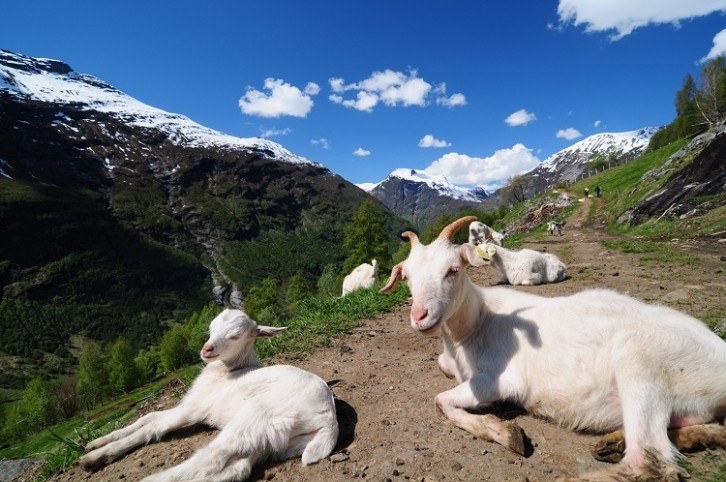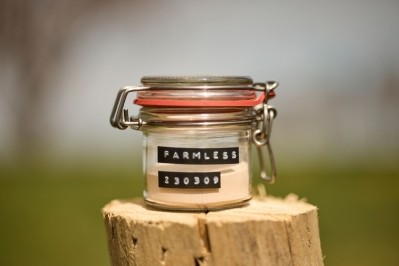'Once the animals are trained, you can pop them out anywhere' - Virtual fence technology could make meat and dairy more sustainable

“The first man,” Genevan philosopher Jean-Jacques Rousseau famously said, “who, having enclosed a piece of ground, bethought himself of saying ‘This is mine,’ and found people simple enough to believe him, was the real founder of civil society.”
Fences and enclosure have always been synonymous with agriculture and, by extension, the origins of human civilisation.
But with modern technology, there are ways to enclose livestock while eschewing such traditional physical barriers. Norwegian company Nofence uses GPS to provide ‘virtual fences’ for cattle, keeping them in the right place without the need for a physical barrier.
GPS agriculture
Nofence was founded by Norwegian goat farmer Oscar Hovde, who wanted to utilise mountainous land for grazing but was restricted by the difficulty of building physical fencing on such land. Nofence’s collars, which its cattle wear and which enables the virtual fences to work, were developed in 2011 and approved in 2016. Soon enough, Nofence’s virtual fence tech spread to the UK.
Here’s how it works: each animal in a herd or flock wears a collar, and each collar is linked to Nofence’s app. With the app, a farmer sets up the animal’s pastures, which are bordered by digitally demarcated barriers, or ‘virtual fences.’ Each collar has an ID number, which can be correlated to an animal.
You can allocate each animal to a pasture. Once the animals are within the pasture and they’ve registered a GPS position there, the boundary is activated.
When animals go over one of the virtual fences set up by the app, they’re confronted with an audio warning. If they keep going, they’re shocked with an electrical pulse.
“The main aim of the collars is to train the animals,” Rachel Fuller, business development manager at Nofence, told FoodNavigator.
“They're trained within a physical fenced area initially, and you train them to turn round when they hear the audio warning, so the pulse is a last resort, once they've learned the system, they then hear the audio warning and learn to turn around when hearing that audio warning.
“Once the animals are trained, you can pop them out anywhere: upland areas, or you can do rotational grazing. And they've learned to turn around on that audio warning, so you see a very low impulse to audio ratio, you can get animals that learn to graze within the audio zone, because it's a sound that increases in pitch.
“And as it increases in pitch, it gets to the highest note, that is when the pulse is issued. So you do get some animals that will learn to graze within that audio zone and then turn around in at the last pitch of the sound.”
Some problems are presented, Fuller told us, by the fact that not all areas have good GPS signal. “If you've got absolutely no mobile phone connectivity . . . then the system is not going to work for you. We do have that conversation with farmers as part of the sales process.”
However, it very much depends on the situation, and in some cases the signal is less integral to the system’s working. “If you were a farmer who wanted to strip graze and do daily moves, for example, with the animals, then yes, you do need a signal,” Fuller told us.
“However, if you're looking at grazing upland areas, or the more conservation type grazing management systems, where the animals are in a larger area, and they're moving the boundaries a lot less often, then you can't get away with a slightly patchy or intermittent signal in places.”
Sustainability for the meat and dairy industry
The meat and dairy industry contributes significantly to climate change, both through methane produced by livestock and deforestation to clear agricultural land. Nofence’s technology, however, means that the process of rearing livestock is better for the environment than it otherwise would be.
“Nofence enables improved grazing management, making it easier for the farmer to implement rotational grazing systems,” Fuller told us, “pastures can easily be set up and changed in the Nofence app significantly reducing the time and labour it takes to move physical fence boundaries."
Rotational grazing has benefits for soil health and biodiversity, she explained, adding that allowing the grass to recover between each grazing rotation can also extend the grazing season and help farmers allocate pasture requirements more effectively.
“Upland grazing areas can be opened up and grazing data can also be viewed so farmers can see where the livestock predominantly graze allowing them to manage land better in extensive systems.”
In harmony
Physical fences have historically been symbolic of man’s dominance over nature. Nofence’s virtual fences, by contrast, work in harmony with it. The pasture is no longer an encroaching manmade territory, not damaging or even inconveniencing other wildlife.
“You've got no physical fencing for wildlife to get trapped in,” Fuller pointed out, “for example, you can maintain and manage water course and river edges and things like that much easier with the virtual fencing, so the wildlife benefits are really quite strong from a virtual fencing point of view, when you're looking in comparison with physical fencing.”

Virtual fences are also not as easily affected by storms as traditional fencing. “If there's a storm coming in, and you don't want areas to get poached, for example, you can move the cattle to a drier or sheltered area, and then allow them back out into the open once that storms pass.
“So you can manage the rotation of the grazing a lot better, give that grazing greater rest periods. You’ve also got the soil health, you've got the biodiversity benefits that come with it.”
You can even escape from flooding more easily. “In, for example, areas that might flood, you can graze through the summer . . . and you've not got that issue of fences being destroyed by flooding and things like that.
“So you can graze in areas that you might not be able to graze otherwise. Certainly from a conservation grazing point of view and an upland farming point of view, you can open up grazing access, which is beneficial for the farmer and the animal, but beneficial for the environment as well.”
Unlike with traditional fencing, there is a clear system built in which will tell farmers if their charges have escaped.
“In a predator situation,” Fuller told us, “if an animal crosses the boundary, the collar would emit three series, so you could get an audio and a pulse, followed by another audio and a pulse, and then a third audio and a pulse.
“If the animal has gone through that boundary, they will be classed as escaped, and a notification is sent from the collar to the app, so the farmer knows that the animal has escaped, they can track its position.
“So obviously, if an animal does cross the boundary, you can very easily find wherever it is, and get it back to its herd.”
The advantage with this is that, unlike with a break in a physical fence, an animal escaping from a virtual enclosure will not necessarily mean a mass exodus – with a virtual fence, one escape does not make more escapes more likely.
Furthermore, with a virtual fence an animal can return back to the herd with no risk of injury, something you couldn’t necessarily say of a physical fence.
If a collar stops reporting, on the other hand, it will turn from white to yellow on the app, alerting the farmer to the fact that they have an animal not constrained by the virtual fence.
“Generally, if it's just one collar, that animal will stay with the herd anyway,” Fuller said. “But yes, we would be straight on it. And we have an ongoing support team for that to help if that situation does occur.”
The future of Nofence
After Norway and the UK, Nofence plans to expand its technology into Spain and the US. “We've got agriculture industries in Spain, they do a lot of fire prevention grazing in Spain as well,” Fuller told us.
“So collars are literally just starting to be sold commercially in Spain. We have commercial pilots running in America, at the moment in the US, and we've just setting up an office in America, as well as in Spain.
“And then we have research pilots going on in other countries where they're looking at the technology and how they can implement it within those countries.”
And virtual fences are adaptable to a range of different environments. “Norway tends to have a set grazing season of April to end of October time,” Fuller told us. However, “in the UK, we see a lot more winter grazing. And it just gives the opportunity if you can do that rotational grazing, you can make a bit more use of your land.
“Spain tends to see the slight opposite, they tend to see grazing seasons through autumn, winter, and spring. And because of extreme heats, they do get animals, particularly in the south, tend to be brought in during those hot summer months.
“And America being such a large country can see all sorts of different grazing systems depending on the state that they're using it in.
“But what Nofence does do, it does allow and improve management of the grassland that you have available or opening up additional areas as well, upland areas. And all that means is that you can get the livestock outside for longer, which has animal welfare benefits. And it has environmental benefits as well.”




























